AI Is Reshaping How Seniors Shop for Medicare. Can Your Marketing Keep Up?
Justin Stauffer Boomer Marketing, Creative That Sells, Digital Direct Marketing, Health Care Marketing, Insurance Direct Marketing, Marketing Analytics, Medicare Marketing, Response Marketing, Trends and POVAs marketers, it is impossible to overstate the impact AI has already had on our industry. AI is mentioned in nearly every blog post (ironically, this post is no exception!). Giants like Google and OpenAI continue to compete by releasing new features. Webinars focused on AI in marketing are everywhere.
At this point, the inherent value of AI is not in question. The question is: How do you integrate AI into a CMS-regulated, compliance-heavy Medicare Advantage marketing program without compromising safety and accuracy (and your own sanity)?
While health plans may hesitate due to perceived risk, a lack of oversight, or a general “wait and see” mindset, consumers are already moving forward.
According to a recent survey, 36% of respondents have used AI to help understand complicated insurance information. Of these respondents, 33% used it to compare plans and 25% to explain overwhelming coverage terms. While it’s highly probable that this survey skews younger, we also know that 57% of adults aged 50+ use (AI powered) voice-assisted search at least daily. Collectively, these trends signal a need for marketers to evolve their strategies in line with consumer behavior.
The AI adoption gap: consumers vs. health plans
Let’s start with a few areas where the challenges are most evident in our industry.
Health insurance shoppers are:
- Entrusting tools like ChatGPT with personal health information (PHI), even though these tools were not designed for use with private health data. This may include asking which plans cover their prescriptions or have their physician in-network.
- Using Google’s AI Mode to summarize complex plan-related documents and compare competing plan benefits.
- Interacting with AI indirectly through voice assistants like Alexa/Google/Siri and voice search, which are largely powered by AI and machine learning.
Health plans, on the other hand, are:
- Constrained by CMS approvals that strictly limit messaging.
- Largely avoiding generative AI tools due to regulatory risk and workflow uncertainty.
- Seeing a decline in overall web traffic over the past few years.
This contrast creates the potential for a significant disconnect in terms of personalization, technology, and relevance.
AI is changing how consumers view your plan
Whether consumers are fully aware of it, they are increasingly relying on information generated outside of your ecosystem. Said differently, your plan’s website historically functioned as the primary source of truth, but in the AI era, it’s become more like another source of data. It’s now also a place where large language models (LLMs) extract and repurpose information to answer consumers’ questions. Although CMS has oversight of plan-related information, gen-AI is not bound to these rules (at least not yet!).
For example, a user might ask ChatGPT: “What Medicare Advantage plans are best in Tennessee?”
AI compiles a response using information scraped from your site, competitors’ sites, CMS.gov, and third-party aggregators. The answer is delivered instantly. No click is required.
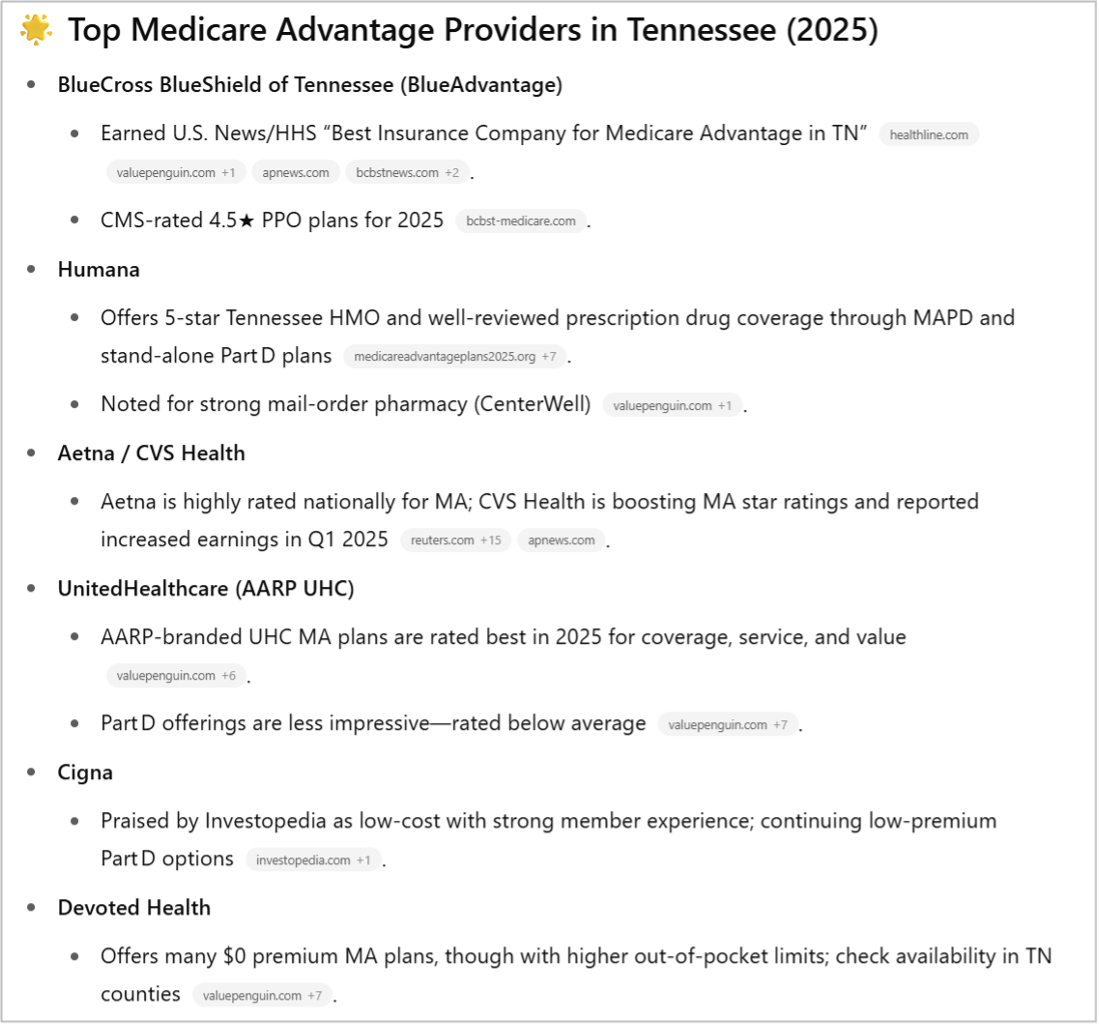
This means your website isn’t just being crawled. It’s being interpreted, summarized, and often paraphrased without context or any ability to have a compliance review of the data being presented. After all, LLMs can interpret and recompile data without your consent. Case in point: Ask your Compliance team if you can say your plan is a “Top Medicare Advantage Provider” in your next marketing campaign as this screenshot from ChatGPT suggests. (Spoiler alert: not going to happen!)
4 ways to integrate AI today
1. Optimize your website content for AI discoverability
Look for Generative Engine Optimization (GEO) to become a bigger buzzword. Just as SEO improves content readability for search engines, GEO focuses on making your content a preferred source for AI models — so it gets cited or summarized in generative responses, even if users never click through to your website. Like SEO, best practices for GEO include writing in plain language, structuring content to answer specific questions, and keeping plan-related content up to date.
Beyond Google Trends, we like answerthepublic.com for input on specific questions consumers are asking.
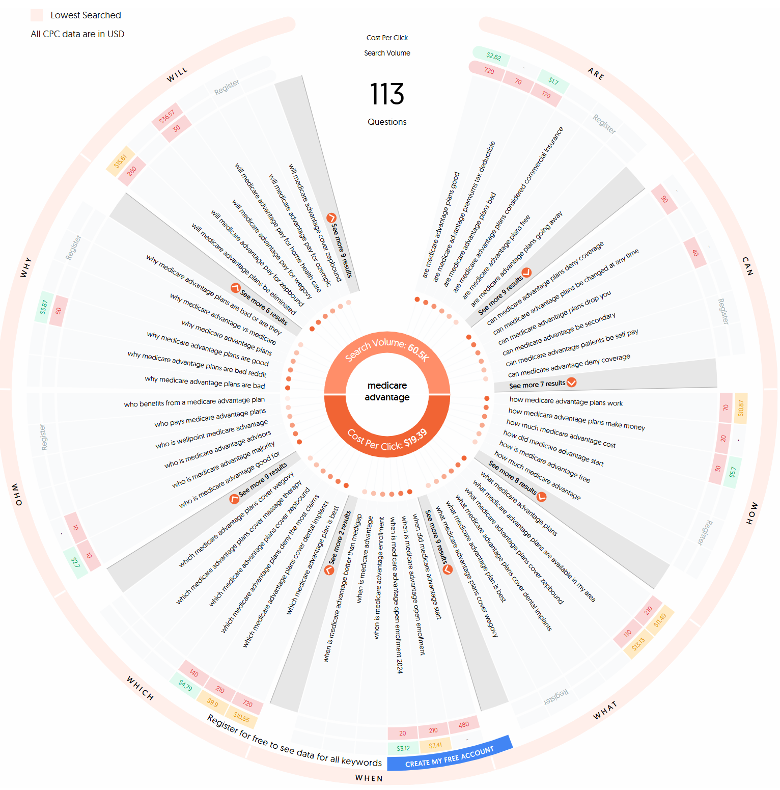
2. Make content machine-readable using Structured Data
Structured Data markup is not new; it’s finding a renewed importance in the AI era. When implemented correctly, structured data allows search engines and generative AI platforms to interpret your site content more accurately.
Think of it like giving content site-specific categories or folders so machines can better understand what to display in response to a user’s query. Tools like Schema Markup Validator can help ensure your site is tagged correctly.
This is especially useful in plan listings, FAQs, educational articles, or enrollment guides. Structured Data also improves accessibility for screen readers and voice search.
Without Structured Data, you’re leaving your content open to misinterpretation, which is particularly risky in our industry. Even if you can’t fully read code, you should be able to interpret a series of categories and resulting values, such as those in the example below.
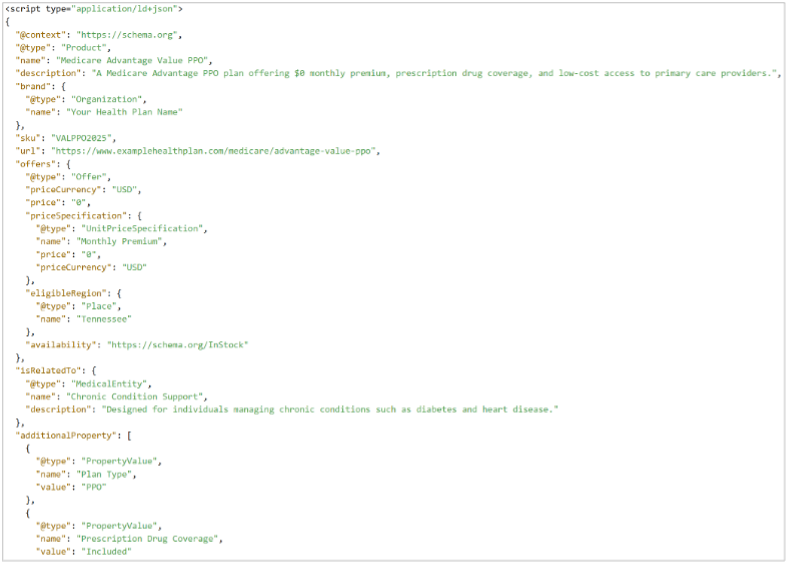
3. Embrace AI-powered ad campaigns — within the limits of compliance
While consumer behavior is shifting rapidly thanks to generative AI, many health care marketers are still stuck deploying rigid, preapproved campaign assets that can’t easily shift in response to performance data, mid-campaign.
In the Medicare Advantage space, this is especially difficult due to CMS regulations that require materials to be reviewed. For digital media, this means a 5-day “file and use” requirement, which may not seem like the end of the world, but does complicate the ability to quickly iterate and pivot in the 68-day AEP marketing window. Fortunately, tools like Meta’s Advantage+ and Google’s Performance Max (PMAX) offer pre-launch opportunities that can support Medicare Advantage campaigns if used strategically.
Meta’s Advantage+ creative enhancements automatically enhance your visuals and text based on engagement predictions. Depending on the ad format or placement, different creative enhancements may be available. Some noteworthy enhancements may include image, video, and 3D animations; dynamic calls to action, music, and more. While more advanced features like AI text generation may not yet be available to new accounts, the platform still potentially reduces friction in creative testing.
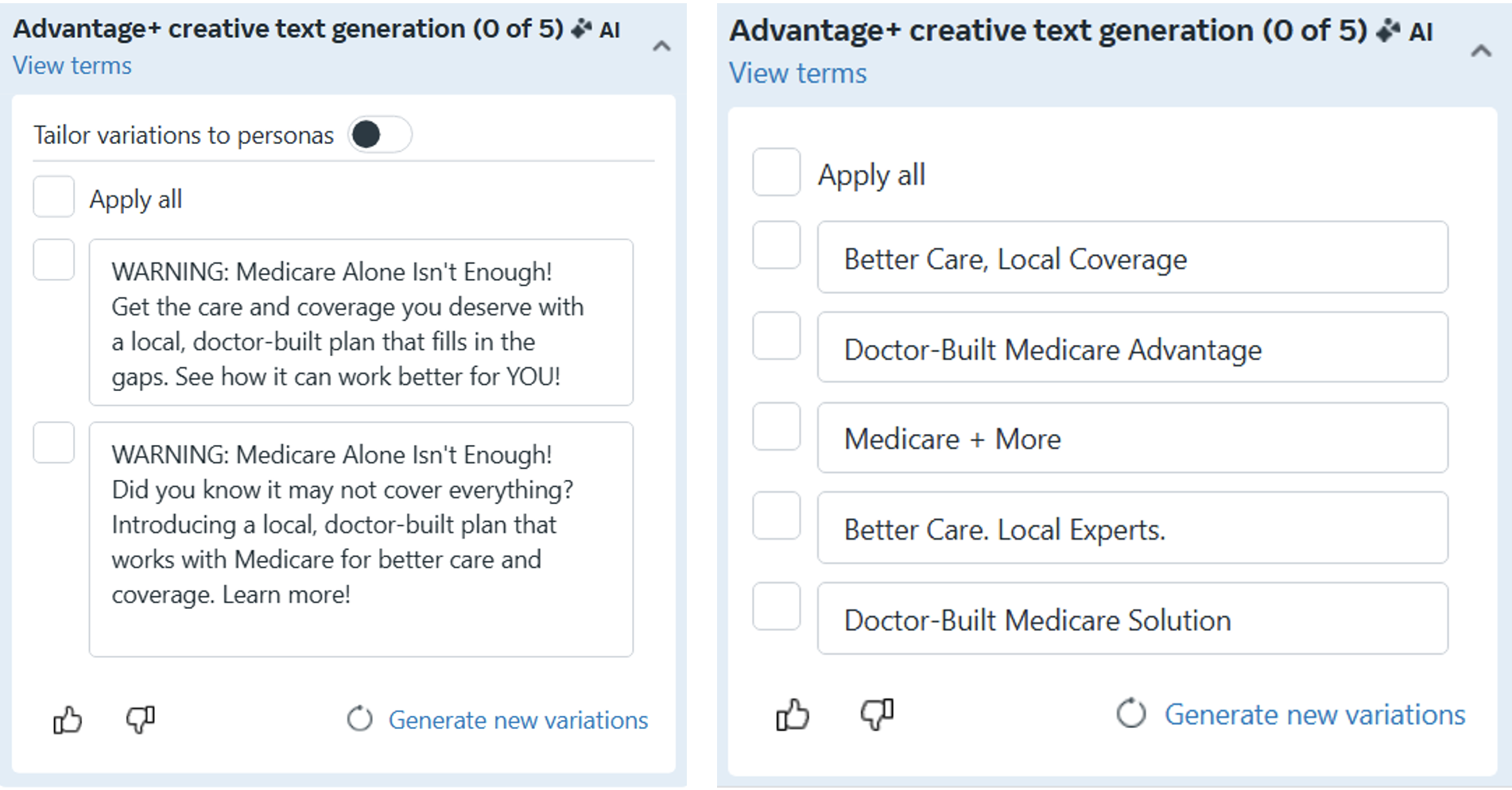
Google (and Microsoft’s) PMAX uses AI to generate headlines, descriptions, and visuals by analyzing your website and campaign inputs. You retain full editorial control and can refine generated content before launching, making it more suitable for CMS-required approvals in your campaigns.
Google also gives you the ability to supplement content generation by adding additional links to other “owned” properties to help with image generation.
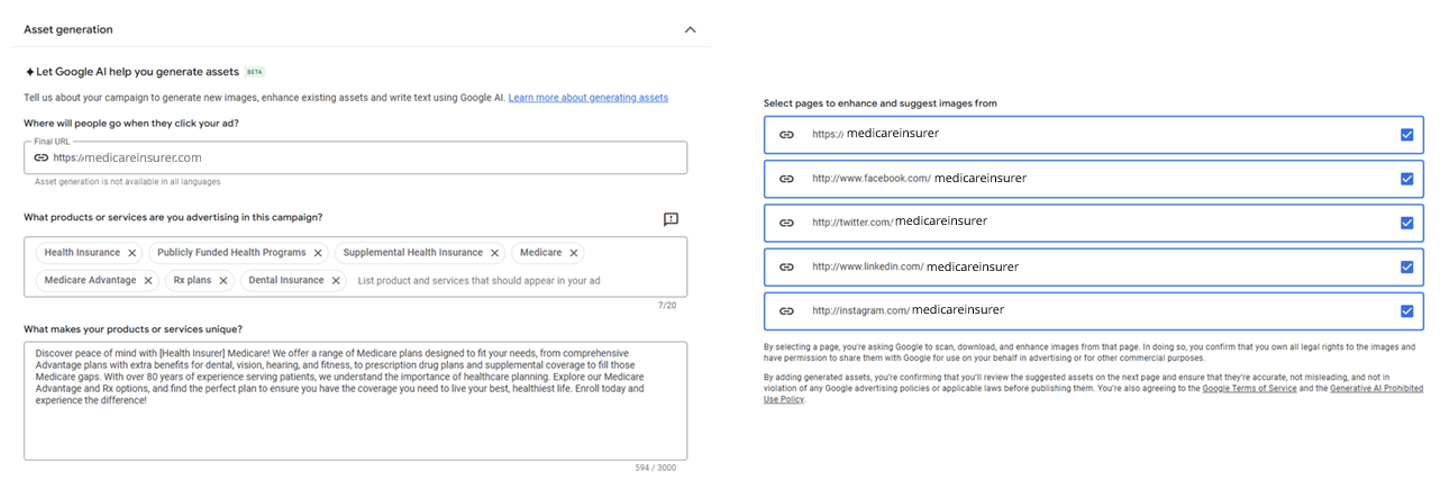
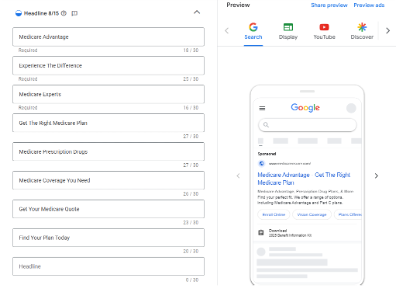
These tools are especially useful at generating multiple permutations of messaging prior to CMS submission. Pending filing and use, you can arguably test more creative directions, build multiple compliant copy variations, and refine performance-informed messaging before your campaigns go live.
Remember, AI shouldn’t focus on replacing your internal compliance process, but it can help make it faster, more informed, and more efficient.
4. Use generative AI within Google Analytics (GA4) to uncover smarter insights
As more search behaviors shift to gen-AI tools, understanding how users find your site and what they do next is key to adapting your strategy. Fortunately, AI is now also embedded in how you analyze the performance of your campaigns. For instance, with GA4, marketers gain access to Ask Analytics Intelligence, a feature that’s powered by AI and machine-learning to function almost like an assistant that sifts through data and brings important information to your attention, saving you time and effort in data analysis.
It can generate custom insights, predict behaviors, and detect anomalies or unusual trends in your site’s performance. It helps users, even those with limited analytics knowledge, discover important web performance-related information quickly. Users can select from a series of predefined queries or type their own. Additionally, by selecting “more suggestions,” Google will provide more possible questions to display related to performance results.
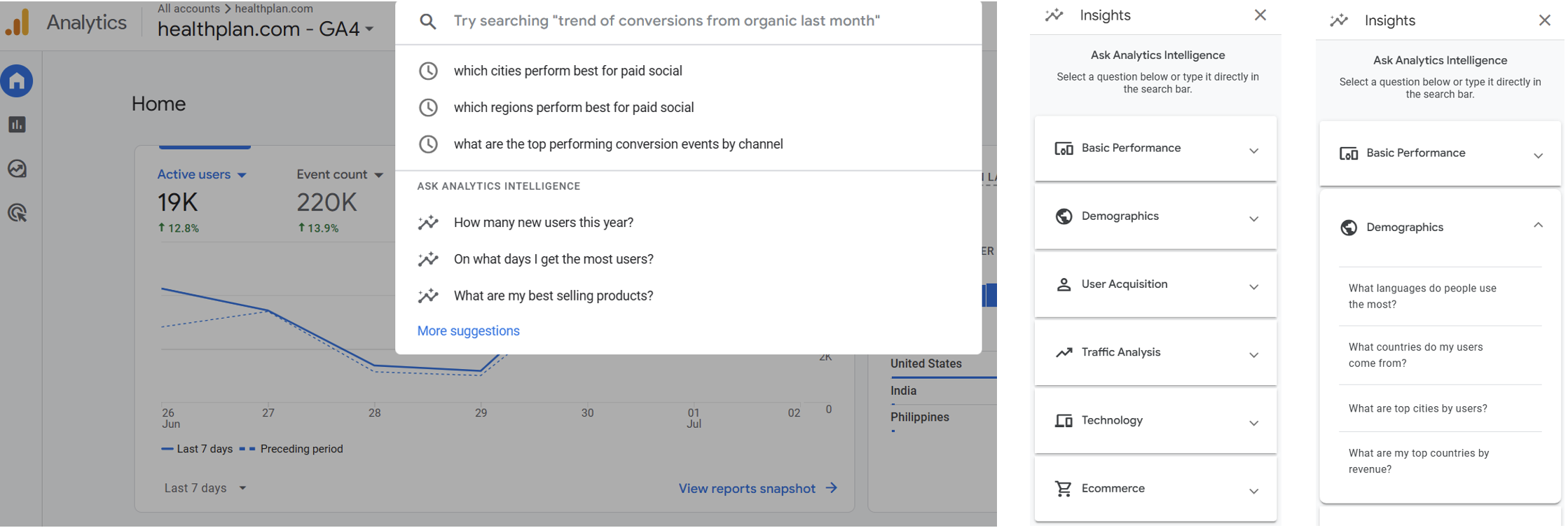
You can also use the “Explore Reports” feature, which allows you to perform tasks like segment traffic from AI-powered platforms like ChatGPT and others. This helps answer critical questions like:
- What content are AI tools surfacing from your site?
- Which pages attract this traffic?
- How can messaging be adjusted to better align with AI-driven queries?
These reports can help advertisers analyze how much of their organic traffic is coming from gen-AI tools. It is important to keep an eye on tools like this as the SEO and GEO ecosystem continues to evolve.
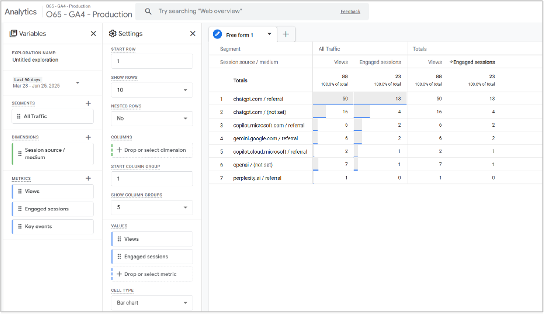
We’re in the AI era, too — and here to help
DMW understands the unique challenges of AI adoption in insurance marketing. From navigating CMS compliance to building scalable, test-ready strategies, we help health plans utilize AI while still adhering to industry- and compliance-related constraints.
Whether you need support auditing your website, exploring compliant creative, or executing responsible AI-driven campaigns, we’re here to guide the way. Reach out.